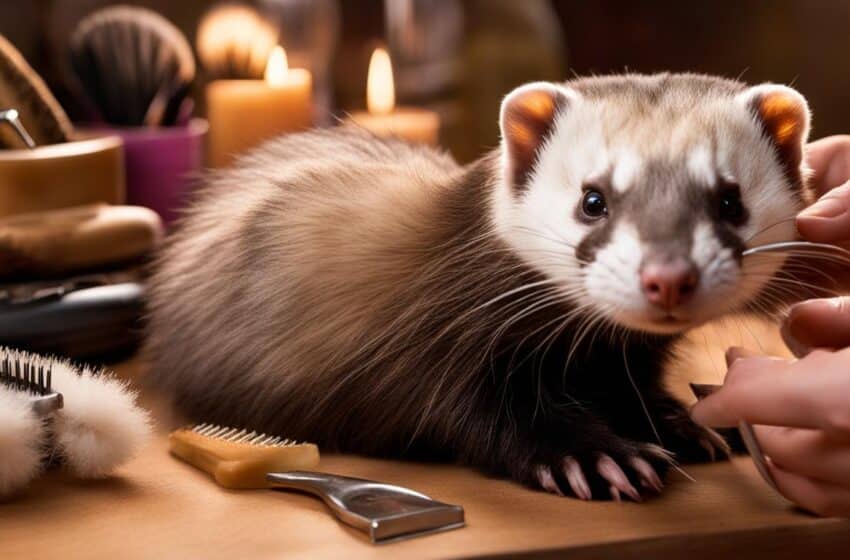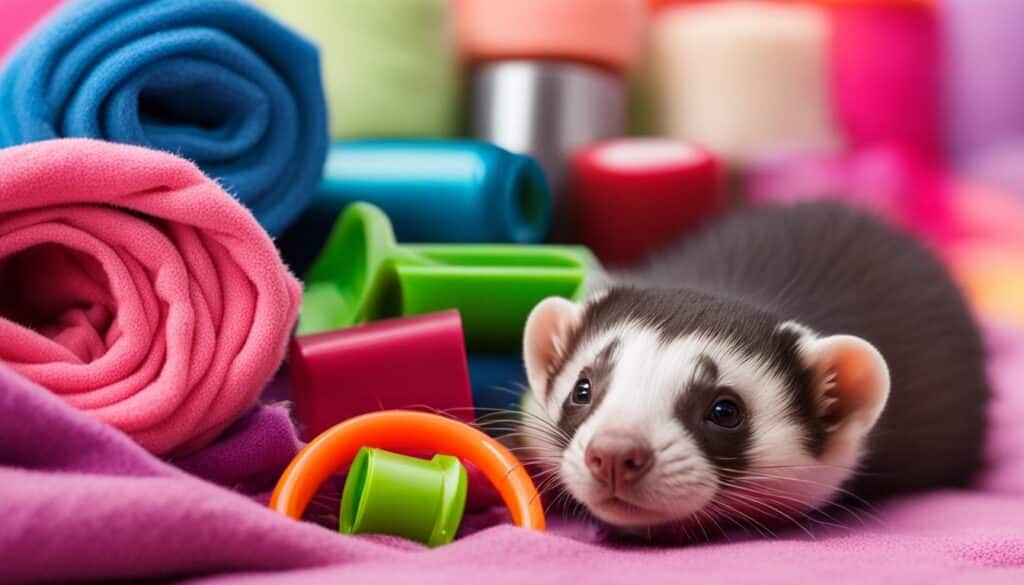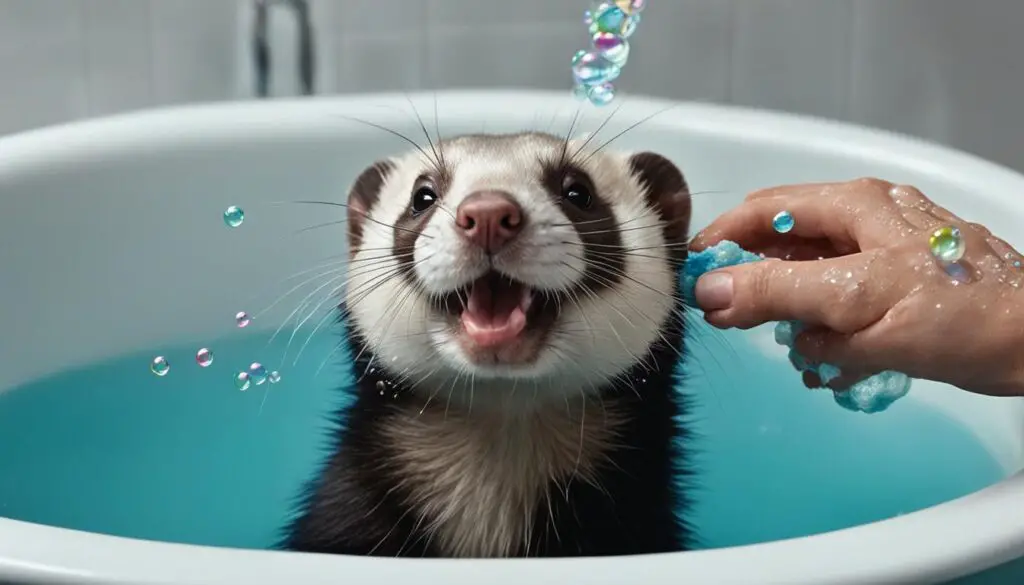Basic Grooming Techniques for Ferrets

As a ferret owner, it’s important to understand the basics of grooming techniques to ensure the health and happiness of your furry friend. Regular grooming not only keeps your ferret looking clean and well-maintained but also plays a vital role in their overall well-being. In this article, I will share essential tips and insights on how to groom your ferret effectively.
Key Takeaways:
- Regular grooming is essential to maintain the health and hygiene of your ferret.
- Grooming helps prevent skin issues, infections, and excessive shedding.
- Ensure you have the necessary supplies, including a soft brush or comb, ferret-specific shampoo, nail clippers, and a toothbrush.
- Brush your ferret’s coat regularly to remove loose hair and prevent matting. Pay attention to areas prone to matting.
- Bathe your ferret when necessary using a ferret-specific shampoo and lukewarm water. Avoid the head and ears.
Why is Grooming Important for Ferrets?
Grooming is crucial for the overall health and well-being of ferrets. Regular grooming provides numerous benefits for these adorable pets, ensuring they stay happy and comfortable. Let’s explore the importance of grooming and the health benefits it offers for ferrets.
“A well-groomed ferret is a healthy ferret.”
Importance of Ferret Grooming
Grooming plays a vital role in maintaining the health and hygiene of ferrets. It involves taking care of their fur, skin, teeth, and nails. By regularly grooming your ferret, you can:
- Promote skin health: Regular grooming removes dirt, oil, and debris from the fur, preventing skin issues and infections.
- Minimize shedding: Brushing your ferret’s coat helps to reduce shedding, keeping your home clean and your ferret comfortable.
- Improve coat condition: By removing tangles and mats, grooming keeps your ferret’s coat shiny, smooth, and free from discomfort.
- Monitor health: Grooming provides an opportunity to examine your ferret’s skin for any signs of irritation, lumps, or abnormalities. It also allows you to check their teeth and nails for potential issues.
Grooming also helps to strengthen the bond between you and your ferret, as they become accustomed to the grooming routine and the gentle touch of your care.
Grooming Routine for Ferrets
Establishing a grooming routine early on is key to ensuring the process is stress-free for both you and your ferret. Here’s a simple grooming routine you can follow:
- Brushing: Use a soft brush or comb to gently brush your ferret’s coat, removing any loose hair and preventing matting. Pay special attention to areas prone to matting, such as the neck, armpits, and tail base.
- Bathing: Ferrets generally don’t require frequent bathing unless they get dirty or have an odor. Use a ferret-specific shampoo and lukewarm water to bathe your ferret when needed.
- Nail trimming: Trim your ferret’s nails regularly to prevent overgrowth. Use a specialized nail clipper or ferret claw trimmer to trim the nails, taking caution to avoid cutting too close to the quick.
- Dental care: Brush your ferret’s teeth using a toothbrush designed for ferrets and a toothpaste formulated for their dental needs. Gradually introduce toothbrushing to your ferret’s routine, ensuring their dental health is maintained.
Remember, patience and gentle handling are crucial during the grooming process. Make sure to reward your ferret with treats and praise to positively reinforce their cooperation.
| Grooming Benefits | How to Achieve |
|---|---|
| Promotes skin health | Regular brushing and bathing |
| Minimizes shedding | Regular brushing and proper nutrition |
| Improves coat condition | Regular brushing and grooming products |
| Monitors health | Gentle examination during grooming |
Supplies Needed for Ferret Grooming
Before you start grooming your ferret, it’s important to have the necessary supplies on hand. Proper grooming tools and products will help make the process easier for both you and your furry friend. Below are some essential grooming items for ferrets:
Grooming Tools
- Soft brush or comb: A gentle brush or comb specifically designed for ferrets will help remove loose fur and prevent matting.
- Nail clippers: Trimming your ferret’s nails regularly is crucial for their comfort and safety.
- Toothbrush: Brushing your ferret’s teeth promotes good dental health and prevents dental issues.
Grooming Products
- Ferret-specific shampoo: Choose a shampoo formulated specifically for ferrets to keep their coat clean and healthy.
- Towel: Have a towel ready for drying your ferret after bathing or during grooming sessions.
Using grooming supplies that are specifically made for ferrets is essential to avoid any potential harm or skin irritation. These products are designed with the unique needs of ferrets in mind, ensuring their safety and well-being.

Comparison of Ferret Grooming Supplies
| Supplies | Features |
|---|---|
| Ferret-specific shampoo | Gentle formula to prevent skin irritation, removes dirt and odor |
| Soft brush or comb | Gently removes loose fur, prevents matting |
| Nail clippers | Specially designed for ferrets, easy to use and prevents overgrown nails |
| Toothbrush | Helps maintain dental hygiene, prevents dental issues |
| Towel | Used for drying after bathing and during grooming sessions |
Having the right supplies ensures that you can groom your ferret effectively and keep them clean, healthy, and happy.
Brushing Your Ferret’s Coat
Grooming your ferret’s fur is an essential part of their care routine. Regular brushing helps remove loose hair and prevents matting, keeping their coat healthy and beautiful. Here are some tips for brushing your ferret’s coat:
- Choose the right brush: Use a soft brush or comb specifically designed for ferrets. These tools are gentle on their delicate skin and fur.
- Brush in the direction of hair growth: Gently brush your ferret’s fur in the direction of hair growth. This reduces the risk of causing discomfort or pulling their hair.
- Pay attention to problem areas: Focus on areas prone to matting, such as the neck, armpits, and tail base. Use your fingers or a mat breaker tool to carefully separate any tangles or mats.
- Avoid using scissors: It’s important to avoid using scissors to cut out tangles or mats. This can lead to accidental injuries and harm your ferret.
Regular brushing not only keeps your ferret’s coat looking its best but also strengthens the bond between you and your furry friend. Set aside some time each week for a grooming session to ensure your ferret stays clean and comfortable.
| Benefits of Brushing Your Ferret’s Coat |
|---|
| 1. Removes loose hair |
| 2. Prevents matting and tangles |
| 3. Reduces shedding |
| 4. Stimulates blood circulation |
| 5. Promotes a healthy and shiny coat |
Bathing Your Ferret
Ferrets generally do not require frequent bathing unless they have an odor problem or become excessively dirty. However, when it’s time for a bath, it’s essential to follow the right bathing routine to ensure your ferret’s cleanliness and well-being.
Step 1: Gather the necessary supplies
Before you begin bathing your ferret, gather all the necessary supplies. You will need:
- A soft towel
- A small tub or basin
- Lukewarm water
- Ferret-specific shampoo
- A gentle brush or comb
Step 2: Prepare a comfortable bathing area
Choose a suitable area for bathing your ferret. It can be a sink, bathtub, or a basin. Place a towel at the bottom of the sink or basin to provide traction and prevent slipping. Also, make sure the room is warm enough to avoid chills.
Step 3: Gently introduce your ferret to water
To make the bathing experience less stressful for your ferret, gradually introduce them to the water. Start by wetting their paws and gradually move upwards. Avoid pouring water directly on their head and ears.
Step 4: Apply the ferret-specific shampoo
Once your ferret is wet, apply a small amount of ferret-specific shampoo to your hands and gently massage it into their fur. Focus on areas that are particularly dirty or greasy. Be careful not to get shampoo in their eyes or ears.
Step 5: Rinse thoroughly
Thoroughly rinse your ferret’s fur to remove all traces of shampoo. Use lukewarm water and ensure that no shampoo remains on their skin, as it can cause irritation.
Step 6: Dry your ferret
After rinsing, carefully lift your ferret from the bath and place them on a soft towel. Pat their fur dry gently, removing excess moisture. If your ferret is comfortable with it, you can use a hairdryer on the lowest cool setting to speed up drying. Avoid using the hairdryer too close to their face.

“Regular bathing can keep your ferret’s fur clean and fresh, maintaining their overall hygiene.”
Regular bathing, when necessary, can keep your ferret’s fur clean and fresh, maintaining their overall hygiene. Remember to use a ferret-specific shampoo and lukewarm water for a gentle and effective cleaning. By following these bathing routines, you can ensure that your ferret stays clean, comfortable, and healthy.
Nail Trimming
Regular nail trimming is essential for the well-being of your ferret. Overgrown nails can cause discomfort and may lead to problems with mobility. By keeping your ferret’s nails properly trimmed, you can prevent these issues and ensure their overall comfort and health.
The Importance of Nail Care for Ferrets
Trimming your ferret’s nails is crucial for several reasons:
- Prevents overgrowth: Regular trimming prevents the nails from becoming too long and cumbersome.
- Avoids discomfort: Overgrown nails can curl and dig into your ferret’s paws, causing pain and distress.
- Prevents injury: Long nails are more likely to get caught in objects, leading to potentially serious injuries.
To maintain your ferret’s nail health, you’ll need a small, specialized nail clipper or a ferret claw trimmer. These tools are designed to safely and effectively trim your ferret’s nails without causing any harm. It’s important to handle the trimming process with care and follow proper techniques to ensure a safe and comfortable experience for your pet.
Trimming Your Ferret’s Nails
When trimming your ferret’s nails, it’s crucial to be cautious and avoid cutting too close to the quick, which is the pink area inside the nail that contains blood vessels. Cutting into the quick can cause pain and bleeding.
Here’s a step-by-step guide for trimming your ferret’s nails:
- Prepare a calm and quiet environment where your ferret feels comfortable. You may want to have someone assist you in holding your ferret gently and securely.
- Gently hold your ferret’s paw and extend its nails to expose the length.
- Identify the quick by looking for the pink area. It’s usually clearly visible, especially in lighter-colored nails.
- Cut the nail just above the quick, leaving a safe amount of the nail intact. It’s better to trim less and be more frequent than risking injury.
- If your ferret’s nails are dark and it’s challenging to see the quick, trim a small amount at a time to avoid cutting into the quick accidentally.
Remember to remain calm and patient throughout the process to keep your ferret at ease. If you accidentally trim the nail too short and it bleeds, apply some styptic powder or cornstarch to stop the bleeding.
Nail Trimming Frequency for Ferrets
| Type of Ferret | Nail Trimming Frequency |
|---|---|
| Indoor Ferret | Every 2-4 weeks |
| Outdoor Ferret | Every 1-2 weeks |
| Older Ferret | Every 1-3 weeks |
Dental Care for Ferrets
Ensuring proper dental care for your ferret is crucial for their overall health and well-being. Just like humans, ferrets can develop dental issues that may cause discomfort and affect their quality of life. To maintain your ferret’s dental health, regular dental care should be a part of their grooming routine.
One essential aspect of ferret dental care is teeth brushing. Regularly brushing your ferret’s teeth helps in preventing tartar buildup, gum disease, and other dental problems. Invest in a specially designed toothbrush or a finger toothbrush that fits comfortably in your hand and is gentle on your ferret’s gums.
Toothpaste formulated for ferrets is recommended for brushing their teeth. Avoid using human toothpaste as it may contain ingredients that are harmful to ferrets. Alternatively, you can use a plain water rinse if your ferret is not comfortable with toothpaste initially.
Introducing your ferret to toothbrushing gradually is crucial to make the process stress-free for both of you. Start by getting your ferret familiar with the toothbrush. You can do this by allowing them to sniff and lick the toothbrush while offering positive reinforcement, such as treats and praise.
Once your ferret is comfortable with the toothbrush, you can begin gently brushing their teeth. Hold the toothbrush at a 45-degree angle to the teeth and brush in a circular motion. Focus on the outer surfaces of the teeth, as this is where most plaque and tartar accumulation occurs. Be sure to brush along the gumline as well.
Start with short brushing sessions and gradually increase the duration as your ferret becomes more accustomed to the process. Patience and consistency are key when it comes to teeth brushing for ferrets.
In addition to teeth brushing, you can provide dental treats or toys specifically designed to promote dental health in ferrets. These treats and toys help to stimulate chewing and promote healthy teeth and gums.
Regular dental care, including teeth brushing and the use of dental treats, will go a long way in maintaining your ferret’s dental health. Remember to consult with your veterinarian if you notice any signs of dental issues or have any concerns about your ferret’s oral health.
Conclusion
Regular grooming is essential for maintaining the overall health and well-being of your ferret. By following the basic grooming techniques discussed in this article, you can ensure that your furry friend remains healthy, comfortable, and happy.
Establishing a grooming routine is key. Make sure to set aside dedicated time for grooming and stick to it consistently. This will not only help maintain your ferret’s hygiene but will also strengthen the bond between you.
Using the right supplies is vital to ensure a safe and effective grooming session. Invest in ferret-specific grooming tools and products to avoid any potential harm or skin irritation. This includes a soft brush or comb, ferret-specific shampoo, nail clippers, and a toothbrush.
During the grooming process, patience and gentleness are crucial. Your ferret may need time to adjust to the grooming routine, so take it slow. Approach each grooming activity calmly and reward your ferret with treats and praise to make it a positive experience for both of you.
In summary, regular grooming, establishing a routine, using the right supplies, and being gentle and patient with your ferret are the essentials of ferret grooming. By incorporating these practices into your ferret’s care, you can ensure that they stay healthy, comfortable, and happy for years to come.
FAQ
Why is grooming important for ferrets?
Grooming is crucial for ferrets as it helps in maintaining their overall health and well-being. Regular grooming removes dirt, oil, and debris from their fur, preventing skin issues and infections. It also helps to minimize shedding and keeps their coat shiny and smooth.
What supplies do I need for ferret grooming?
Some of the essential grooming items for ferrets include a soft brush or comb, ferret-specific shampoo, nail clippers, and a toothbrush. It’s important to use grooming products specifically designed for ferrets to avoid any potential harm or skin irritation.
How do I brush my ferret’s coat?
Use a soft brush or comb to gently brush their fur in the direction of hair growth. Pay extra attention to areas like the neck, armpits, and tail base, where matting is more likely to occur. If you come across any tangles or mats, try to carefully separate them with your fingers or a mat breaker tool.
How often should I bathe my ferret?
Ferrets generally do not require frequent bathing unless they have an odor problem or become excessively dirty. When bathing your ferret, use a ferret-specific shampoo and lukewarm water. Gently massage the shampoo into their fur, avoiding the head and ears. Rinse thoroughly to remove all traces of shampoo and ensure it doesn’t irritate their skin.
How do I trim my ferret’s nails?
Use a small, specialized nail clipper or a ferret claw trimmer to trim the nails. Take caution not to cut too close to the quick, which is the pink area inside the nail. If you’re unsure, it’s better to trim less and be more frequent than risking injury.
How do I take care of my ferret’s dental hygiene?
Regularly brush your ferret’s teeth using a specially designed toothbrush or a finger toothbrush. Use toothpaste formulated for ferrets or a plain water rinse. Start by gently introducing your ferret to the toothbrush and gradually increase the brushing time. You can also provide dental treats or toys specifically made to promote dental health in ferrets.



